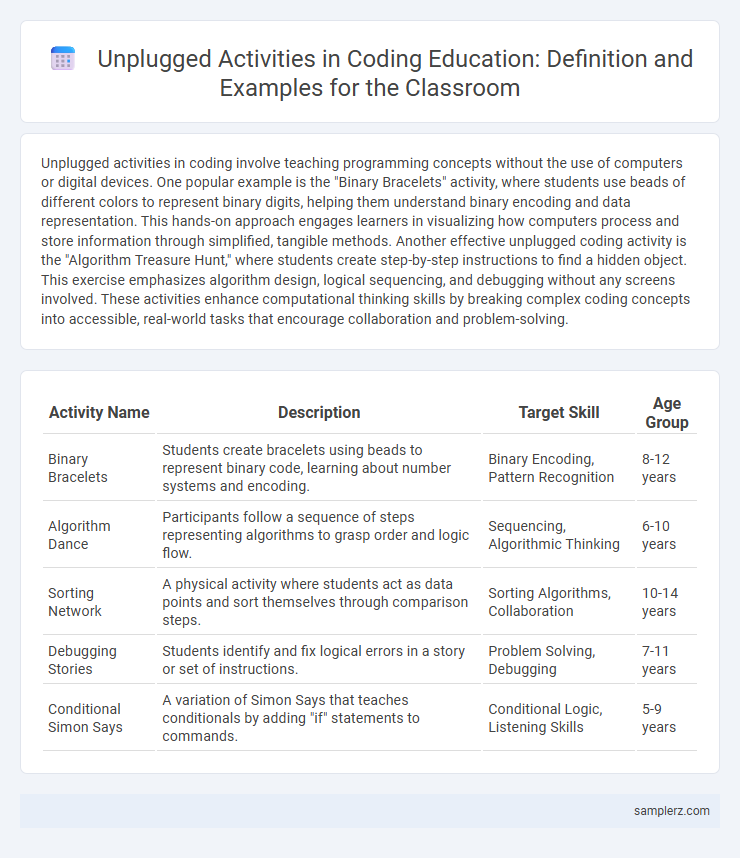Unplugged activities in coding involve teaching programming concepts without the use of computers or digital devices. One popular example is the "Binary Bracelets" activity, where students use beads of different colors to represent binary digits, helping them understand binary encoding and data representation. This hands-on approach engages learners in visualizing how computers process and store information through simplified, tangible methods. Another effective unplugged coding activity is the "Algorithm Treasure Hunt," where students create step-by-step instructions to find a hidden object. This exercise emphasizes algorithm design, logical sequencing, and debugging without any screens involved. These activities enhance computational thinking skills by breaking complex coding concepts into accessible, real-world tasks that encourage collaboration and problem-solving.
Table of Comparison
| Activity Name | Description | Target Skill | Age Group |
|---|---|---|---|
| Binary Bracelets | Students create bracelets using beads to represent binary code, learning about number systems and encoding. | Binary Encoding, Pattern Recognition | 8-12 years |
| Algorithm Dance | Participants follow a sequence of steps representing algorithms to grasp order and logic flow. | Sequencing, Algorithmic Thinking | 6-10 years |
| Sorting Network | A physical activity where students act as data points and sort themselves through comparison steps. | Sorting Algorithms, Collaboration | 10-14 years |
| Debugging Stories | Students identify and fix logical errors in a story or set of instructions. | Problem Solving, Debugging | 7-11 years |
| Conditional Simon Says | A variation of Simon Says that teaches conditionals by adding "if" statements to commands. | Conditional Logic, Listening Skills | 5-9 years |
Introduction to Unplugged Coding Activities
Unplugged coding activities, such as binary bead bracelets or algorithm card sorting, effectively introduce fundamental programming concepts without the use of computers. These hands-on exercises help students grasp logic, sequencing, and problem-solving skills by engaging in physical tasks that mirror coding processes. Incorporating unplugged methods into early education fosters computational thinking and prepares learners for more advanced, screen-based programming.
Benefits of Unplugged Coding in Education
Unplugged coding activities, such as using physical cards to simulate algorithm steps or role-playing as data structures, enhance computational thinking without computers. These hands-on experiences improve problem-solving skills, logical reasoning, and collaboration among students, fostering a deeper understanding of coding concepts. By removing screen time, unplugged coding promotes active engagement and accessibility, making coding education inclusive for diverse learning styles.
Simple Algorithms with Everyday Objects
Using everyday objects such as colored blocks or cards, students can practice simple algorithms by following step-by-step instructions to create patterns or sequences. This unplugged activity reinforces foundational coding concepts like loops and conditionals without the need for computers. Engaging in hands-on tasks enhances algorithmic thinking and problem-solving skills essential in computer science education.
Teaching Sequencing through Storytelling
Teaching sequencing through storytelling in coding unplugged activities enhances computational thinking by breaking down complex algorithms into manageable narrative steps. Students create coded stories by arranging story cards or events in logical sequences, reinforcing understanding of order, loops, and conditional logic without using computers. This method improves problem-solving skills and strengthens foundational programming concepts through hands-on, interactive learning.
Debugging Activities Using Paper and Pencils
Debugging activities using paper and pencils help learners develop essential problem-solving skills by manually tracing code logic and identifying errors without a computer. This unplugged method encourages critical thinking and reinforces understanding of programming concepts such as loops, conditionals, and sequence flow. Teachers often provide printed snippets of flawed algorithms, guiding students to spot mistakes and correct them through annotation and step-by-step analysis.
Exploring Conditionals with Card Games
Exploring conditionals in coding can be effectively taught through card games that simulate decision-making processes. For example, a game where players draw cards and follow specific rules based on card attributes allows students to understand "if-then" statements and logical conditions without a computer. This hands-on approach enhances critical thinking and prepares learners for programming concepts by illustrating how conditions control the flow of actions in code.
Binary Numbers with Beads and Coins
Using beads and coins to represent binary numbers helps students visualize how digits correspond to powers of two, reinforcing fundamental coding concepts without a computer. This tactile activity enables learners to convert between decimal and binary by physically grouping items to illustrate bits set to 1 or 0. Engaging in this unplugged method strengthens understanding of binary arithmetic, crucial for programming logic and data representation.
Unplugged Activities for Loops and Patterns
Unplugged activities for loops and patterns in coding include exercises like "Patterned Shapes," where students use colored blocks or paper to replicate repeating sequences, reinforcing the concept of iteration without a computer. Another effective activity is "Human Loops," where learners form groups to simulate loop execution by repeating specific actions in cycles, illustrating loop mechanics physically. These tangible tasks enhance comprehension of programming logic by translating abstract loop concepts into hands-on, visual experiences.
Collaborative Sorting and Searching Exercises
Collaborative sorting and searching exercises in unplugged coding engage students in hands-on problem-solving by physically organizing data or locating elements without digital devices. These activities enhance algorithmic thinking and teamwork by simulating key computer science concepts such as bubble sort or binary search using cards, objects, or numbered cards. Educators report increased student comprehension of sorting algorithms and improved communication skills through these interactive, device-free methods.
Integrating Unplugged Coding into Classroom Lessons
Integrating unplugged coding activities into classroom lessons enhances computational thinking through hands-on tasks like algorithm design using paper-based mazes or sequence cards. These activities foster problem-solving and logical reasoning without the need for computers, making coding concepts accessible to all students. Incorporating unplugged coding supports curriculum standards while promoting collaboration and engagement in diverse learning environments.

example of unplugged activity in coding Infographic
 samplerz.com
samplerz.com